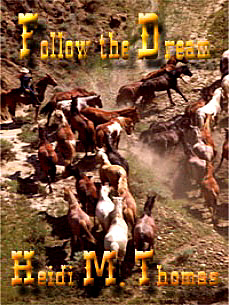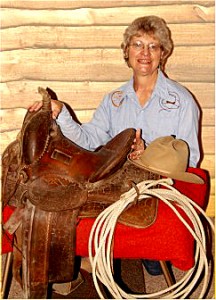
I’ve done a previous post about writer Heidi M. Thomas and she has another great book out.
My friend Clementine is today’s guest blogger

We’re happy to welcome back one of our favorite cowgirls and authors, Heidi M. Thomas. Heidi wrote an article last year when her first book, Cowgirl Dreams, came out. She has a sequel to that book called Follow the Dream, which celebrates the cowgirl spirit. Speaking of that spirit, let me turn it over to Heidi as she riffs about that cowgirl state of mind.
___________________________________________________________________________________________
By Heidi M. Thomas
Dale Evans Rogers defined it well: “Cowgirl is an attitude, really. A pioneer spirit, a special American brand of courage. The cowgirl faces life head on, lives by her own lights, and makes no excuses. Cowgirls take stands. They speak up. They defend the things they hold dear. A cowgirl might be a rancher, or a barrel racer, or a bull rider, or an actress. But she’s just as likely to be a checker at the local Winn Dixie, a full-time mother, a banker, an attorney, or an astronaut.”
“Cowgirl up” is an expression that means to rise to the occasion, not to give up, and to do it all without whining or complaining. It is easy to say “Cowgirl Up.” However, it takes a true cowgirl at heart to live up to the true meaning.
Although I grew up on a ranch in eastern Montana and I rode horses, gathered cattle with my dad, and helped with branding, I never really thought of myself as a cowgirl. But through my years of reading and researching for my books, I’ve come to realize that I am — maybe an “urban cowgirl” by strict definition, but a cowgirl by attitude.
My grandmother was a cowgirl — a real one who not only rode horses, but also rode bucking stock in rodeos in the ’20s & ’30s.
The 1920s was the heyday of rodeo for women. They grew up riding out of necessity alongside their fathers, brothers, and husbands and naturally they were just as competitive in trying to see who could stay on the back of a bucking bronc or steer or roping calves as the men.
Rodeos started out as impromptu events—cowboys betting each other who was going to get bucked off the quickest. Annie Oakley paved the way for women when she gained fame in Buffalo Bill’s Wild West Show as a sharpshooter. Lucille Mulhall, when she was 18 years old, lassoed and tied three steers in 3 minutes, 30 seconds—faster than the best cowboys—and won a gold medal and a $10,000 prize for a world record!
This “cowgirl attitude” is the way my grandmother lived. And I modeled my character, Nettie, on my grandmother and that cowgirl attitude. Nettie has a dream to become a rodeo star and the tenaciousness to follow that dream. In Cowgirl Dreams, during the 1920s, she faces family and social barriers to that dream. The sequel, Follow the Dream, finds her still holding on to her dream. But the drought and depression of the 1930s forces her to make some tough choices and rethink how her dream works in with her family and life in Montana.
Both books are available through my website www.heidimthomas.com and from my publisher Treble Heart Books. Follow the Dream is also available on the Kindle.
___________________________________________________________________________________________
Heidi M. Thomas grew up on a ranch in eastern Montana and now lives in western Washington where she writes, edits for other authors, teaches community writing classes, and blogs. She is a member of Women Writing the West, Skagit Valley Writers League, Northwest Independent Editors Guild, and VBT—Writers on the Move.


Richard, thank you for hosting me today! It’s an honor to be on your blog.